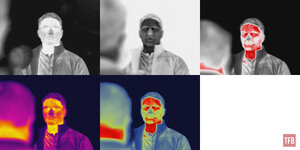Silver Lifetime
- Messages
- 42,757
- Reactions
- 111,036
Traded a SIG Tango 6 for a Burris BTS 35 yesterday.
A few first impressions.
Seems to eat more battery power than advertised - but then the batteries may not have been fully charged? I charged up some overnight and will retry later.
I learned what is hot and what is not. LED lights are not very warm. My asphalt driveway retains a lot of heat. Interesting what parts of my house leak heat - I will learn more come winter. Glass reflects rather than allows one to see thru it - even in the dark I see reflections of trees. Trees are hot, more so during the day (of course). The camo net over my pickup does mask the heat - some - and/or reduces the heat it retains. The radiator on my car radiates heat for hours after being driven. My Starlink dish radiates significant heat.
Not easy to navigate around with just thermal - in fact, I would not want to rely on it alone altogether - at least not this thermal device. I think a thermal/NV hybrid would be a lot better - especially one that had 1X optical (this does not - it is nearer 2X). I had not planned on using thermal for navigation - just an observation. I do think it will be useful for night hunting (e.g., feral pigs). I did try it out at about 3 AM and did not see anything moving around outside - I often have deer/etc. wandering thru my property.
I have not tried the scope with any animals or humans yet - I will be interested to try that at different ranges.
Buildings are detectable - somewhat thru brush/trees - as are vehicles - although sometimes it takes some interpretation.
The moon itself seems to radiate/reflect infrared (I assume that is the spectrum) - some lights in the distance do also (e.g., Beaverton & Portland). Aircraft flying overhead stand out quite a bit - also clouds. Some stars - maybe (I forgot to try that at 3 AM). I think some flying insects or maybe bats do too - maybe the latter - it was just a speck, but was obviously not an aircraft as it moved erratically in a way and at speeds that is not possible with an aircraft - so I assume it was something close by.
I have not tried connecting a recording device to it yet. I would be interested in figuring out a way to connect an external power supply to make the power last longer.
Also, it is disconcerting how much night vision I lose in the eye I am using to view the scope display - makes me almost blind in that eye.
A few first impressions.
Seems to eat more battery power than advertised - but then the batteries may not have been fully charged? I charged up some overnight and will retry later.
I learned what is hot and what is not. LED lights are not very warm. My asphalt driveway retains a lot of heat. Interesting what parts of my house leak heat - I will learn more come winter. Glass reflects rather than allows one to see thru it - even in the dark I see reflections of trees. Trees are hot, more so during the day (of course). The camo net over my pickup does mask the heat - some - and/or reduces the heat it retains. The radiator on my car radiates heat for hours after being driven. My Starlink dish radiates significant heat.
Not easy to navigate around with just thermal - in fact, I would not want to rely on it alone altogether - at least not this thermal device. I think a thermal/NV hybrid would be a lot better - especially one that had 1X optical (this does not - it is nearer 2X). I had not planned on using thermal for navigation - just an observation. I do think it will be useful for night hunting (e.g., feral pigs). I did try it out at about 3 AM and did not see anything moving around outside - I often have deer/etc. wandering thru my property.
I have not tried the scope with any animals or humans yet - I will be interested to try that at different ranges.
Buildings are detectable - somewhat thru brush/trees - as are vehicles - although sometimes it takes some interpretation.
The moon itself seems to radiate/reflect infrared (I assume that is the spectrum) - some lights in the distance do also (e.g., Beaverton & Portland). Aircraft flying overhead stand out quite a bit - also clouds. Some stars - maybe (I forgot to try that at 3 AM). I think some flying insects or maybe bats do too - maybe the latter - it was just a speck, but was obviously not an aircraft as it moved erratically in a way and at speeds that is not possible with an aircraft - so I assume it was something close by.
I have not tried connecting a recording device to it yet. I would be interested in figuring out a way to connect an external power supply to make the power last longer.
Also, it is disconcerting how much night vision I lose in the eye I am using to view the scope display - makes me almost blind in that eye.












